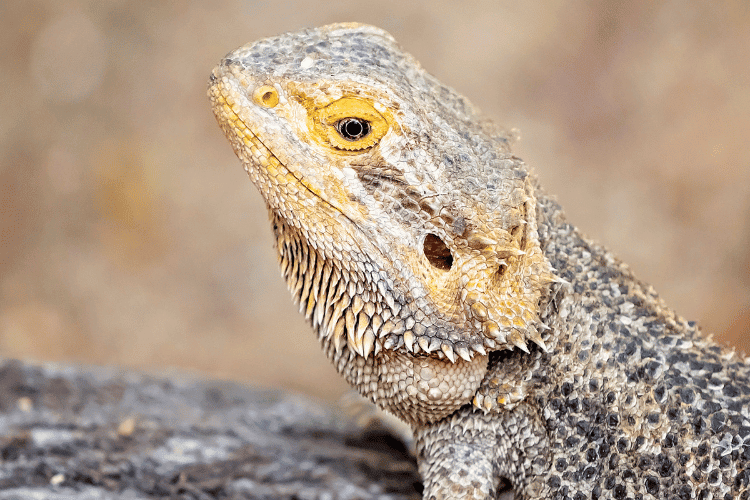As bearded dragon owners, we tend to notice any irregularities with our pets. One common occurrence that can cause concern is the appearance of black spots. While not always a cause for alarm, black spots on a bearded dragon can indicate an underlying health issue that needs attention. In this article, we’ll break down the possible causes of black spots and when you need to seek veterinary care.
What Causes Black Spots on Bearded Dragons?
There are several potential causes for black spots on a bearded dragon
-
Natural Coloration: Some black spots are simply part of the bearded dragon’s normal coloration and skin pigmentation. These small, evenly distributed spots are harmless.
-
Dirt or Debris: Spots that rub off easily are likely just dirt or debris stuck to your dragon’s scales. Give them a gentle bath to clean.
-
Injuries: Scrapes, burns, or other wounds can cause black scabbing as they heal. Look for swelling or oozing as signs of infection.
-
Fungal Infection: Velvety black patches spreading on the skin may indicate a fungal infection. This requires veterinary treatment.
-
Parasites: Bites from parasites like mites or ticks can cause small black scabs on the skin.
-
Scale Rot: A bacterial skin infection, scale rot causes black, crusty patches from too much moisture.
-
Stress Marks: When stressed, bearded dragons get dark spots from blood vessel dilation. Check husbandry.
-
Tail Rot: Injuries on the tail that become infected can cause black, dead tissue at the tip.
What To Do If You Notice Black Spots
If new black spots appear on your bearded dragon, take these steps:
-
Monitor the spots closely for any changes in size, shape, or color.
-
Try to identify the cause, like debris vs. injury vs. infection. Note fuzziness, swelling, scabbing, etc.
-
If spots are growing or you can’t determine the cause, take your dragon to an exotic vet.
-
While monitoring spots, ensure proper husbandry like temperature, humidity, hygiene, diet, and enrichment.
-
Watch for any behavioral changes like lethargy or appetite loss which can indicate illness
How Are Black Spots on Bearded Dragons Treated?
Treatment depends on the underlying cause:
-
For natural coloration, no treatment is needed.
-
Gently wash dirt and debris off with warm water. Avoid soap irritation.
-
Injuries may need antibiotic ointment to prevent infection as they heal.
-
Fungal infections require prescription antifungal medication from your exotic vet.
-
Parasites are treated with spot-on or oral medication to kill mites, ticks, etc.
-
Scale rot is treated by cleaning the area and applying antibiotic ointment. Severe cases may need damaged scale removal.
-
For stress marks, adjust husbandry to lower anxiety. Ensure proper heating, humidity, enclosure size, etc.
-
Tail rot requires antibiotics and removal of any dead tissue. Seek prompt veterinary care.
When Should You Be Concerned About Black Spots?
In most cases, small black spots are harmless normal pigmentation. But you should get prompt veterinary care if you notice:
-
Spots that are rapidly growing or changing color.
-
Spots accompanied by lethargy, swollen limbs, or appetite changes.
-
Signs of infection like oozing, redness, heat, or a fuzzy appearance.
-
Widespread crusty black skin that may indicate scale rot.
-
Any injury to the tail resulting in black tipped scales.
Catching problems early maximizes the chances of effective treatment and preventing a minor issue from becoming serious. When in doubt, call your exotic vet for a check-up. With appropriate care, most causes of black spots are treatable.
Noticing black spots on your bearded dragon can give any owner a scare. But try not to panic right away. Monitor for changes and identify possible causes. Most spots are nothing to worry about. Yet some do require swift veterinary care to treat medical issues. Learn the symptoms that indicate when black spots need a vet visit. And be sure to maintain optimal husbandry to keep your dragon happy and healthy!

HOW TO HEALTH CHECK BEARDED DRAGONS | DO THEY LOOK SICK?
FAQ
Why is there a black spot on my bearded dragon?
One of the most common and telltale signs of stress is dark spots or marks that may appear on your dragon’s chin, neck, and belly. Stress marks are quite common if: Your dragon is shedding. Your new dragon is still adjusting to her home and environment.
What does skin rot look like on a bearded dragon?
Discoloration: Any abnormally dark scales on your pet reptile could be an indication of scale rot, especially on the tail and areas most likely to come in contact with bacteria in substrate or waste.
What does a calcium deficiency in a bearded dragon look like?
Caused by low levels of Calcium and Vitamin D3, it’s by far the most common cause of illness in ‘beardies’. Symptoms can be hard to spot, but can include muscle twitching, swollen legs and fragile bones, which can eventually lead to permanent deformities in the limbs, jaw, spine or tail.
What does a fungal infection look like on a bearded dragon?
It is also known as ‘yellow fungus disease’. This disease can affect bearded dragons at any age and may involve both males and females. This disease is typified by thickened yellow plaques on the face, back, sides, or legs. These plaques will crack, peel, and bleed if not attended to early on.
